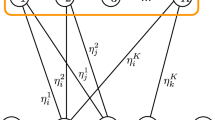Abstract
The associative net as a model of biological associative memory is investigated. Calculating the output pattern retrieved from a partially connected associative net presented with noisy input cues involves several computations. This is complicated by variations in the dendritic sums of the output units due to errors in the cue and differences in input activity and unit usage. The possible implementation of these computations by biological neural machinery is unclear. We demonstrate that a relatively simple transformation can reduce variation in the dendritic sums. This leads to a winners-take-all type of strategy that produces increased recall performance which is equivalent to the more complicated optimal strategy proposed by others. We describe in detail the possible biological implications of our strategies, the novel feature of which ascribes a role to the NMDA and non-NMDA channels found in hippocampal pyramidal cells.
Similar content being viewed by others
References
Bennett M, Gibson W, Robinson, J (1994) Dynamics of the CA3 pyramidal neuron autoassociative memory network in the hippocampus. Philos Trans Roy Soc Lond [Biol] 343: 167–187
Bliss T, Collingridge G (1993) A synaptic model of memory: long-term potentiation in the hippocampus. Nature 361: 31–39
Brown T, Zador A (1990) Hippocampus. In: Shepherd G (ed) The synaptic organization of the brain. Oxford University Press, New York, pp 346–388
Buckingham J (1991) Delicate nets, faint recollections: a study of partially connected associative network memories. PhD thesis, University of Edinburgh
Buckingham J, Willshaw D (1992) Performance characteristics of the associative net. Network 3: 407–414
Buckingham J, Willshaw D (1993) On setting unit thresholds in an incompletely connected associative net. Network 4: 441–459
Collingridge G, Hearn C, Lester R (1988) Synaptic activation of Nmethyl-d-aspartate receptors in the Schaffer collateral-commissural pathway of rat hippocampus. J. Physiol. 399: 283–300
Cotman C, Iversen L (1987) Excitatory amino acids in the brain focus on NMDA receptors. TINS 10: 263–265
Cotman C, Monaghan D (1988) Excitatory amino acid neurotransmission: NMDA receptors and Hebb-type synaptic plasticity. Ann. Rev. Neurosci. 11: 61–80
Eichenbaum H, Buckingham J (1990) Studies on hippocampal processing: experiment, theory and model. In: Gabriel M, Moore J (eds) Learning and computational neuroscience: foundations of adaptive networks. MIT Press, Cambridge, Mass. pp 171–231
Koch C, Poggio T (1987) Biophysics of computation: neurons, synapses, and membranes. In: Edelman G, Gall W, Cowan W (eds) Synaptic function. Neurosciences Institute, Wiley, New York, pp 637–698
Lacaille J-C, Kunkel D, Schwartzkroin P (1989) Electrophysiological and morphological characterization of hippocampal interneurons. In: Chan-Palay V, Köhler C (eds) The hippocampus: new vistas. Liss, New York, pp 287–305
Llinás R (1988) The intrinsic electrophysiological properties of mammalian neurons: insights into central nervous system function. Science 242: 1654–1664
Marr, D (1971) Simple memory: a theory for archicortex. Philos Trans Roy Soc Lond [Biol] 262: 23–81
Marty A (1989) The physiological role of calcium-dependent channels. TINS 12: 420–424
McNaughton B, Morris R (1987) Hippocampal synaptic enhancement and information storage within a distributed memory system. TINS 10: 408–415
McNaughton B, Nadel L (1990) Hebb-Marr networks and the neurobiological representation of action in space. In: Gluck, M, Rumelhart, D. (eds) Neuroscience and connectionist theory. Erlbaum, Hillsdale, pp 1–63
Nadal J-P, Toulouse G (1990) Information storage in sparsely coded memory nets. Network 1: 61–74
Nowycky M, Fox A, Tsien R (1985) Three types of neuronal calcium channel with different calcium agonist sensitivity. Nature 316: 440–443
Palm G (1980) On associative memory. Biol Cybern 36: 19–31
Rolls E (1989) The representation and storage of information in neural networks in the primate cerebral cortex and hippocampus. In: Durbin R, Miall R, Mitchison G (eds) The computing neuron. Addison-Wesley, Wokingham, pp 125–159
Rudy B (1988) Diversity and ubiquity of K Channels. Neuroscience 25: 729–749
Treves A, Rolls E (1994) A computational analysis of the role of the hippocampus in memory. Philos Trans Roy Soc Lond [Biol] (in press)
Willshaw D (1971) Models of distributed associative memory. PhD thesis, University of Edinburgh
Willshaw D, Buckingham J (1990) An assessment of Marr's theory of the hippocampus as a temporary memory store. Philos Trans Roy Soc Lond [Biol] 329: 205–215
Willshaw D, Buneman O, Longuet-Higgins H (1969) Non-holographic associative memory. Nature 222: 960–962
Author information
Authors and Affiliations
Rights and permissions
About this article
Cite this article
Graham, B., Willshaw, D. Improving recall from an associative memory. Biol. Cybern. 72, 337–346 (1995). https://doi.org/10.1007/BF00202789
Received:
Accepted:
Published:
Issue Date:
DOI: https://doi.org/10.1007/BF00202789




